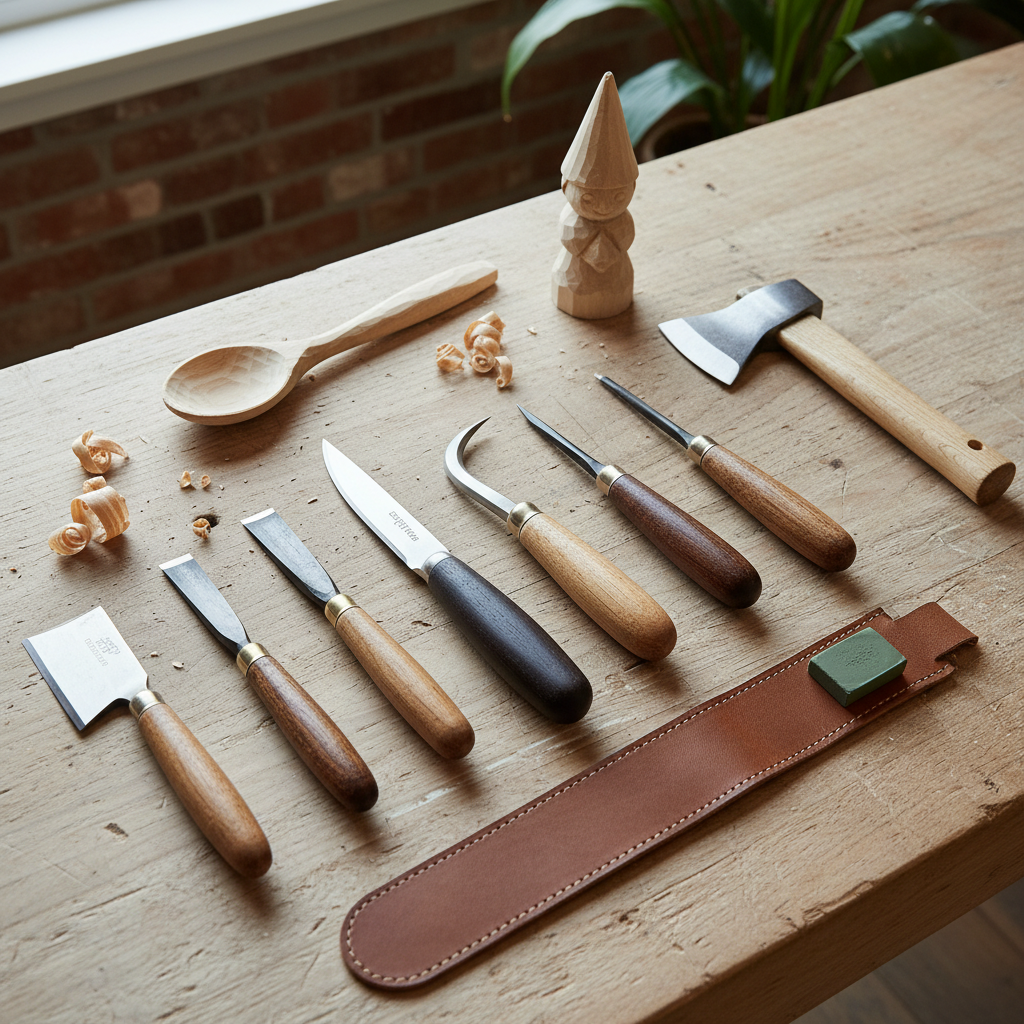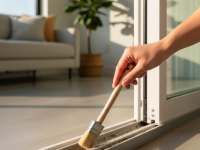Embrace the Art of Nordic Craftsmanship: Your Journey into Scandinavian Wood Carving
There’s a unique magic that comes with holding a piece of wood, feeling its grain, and imagining the form hidden within. For centuries, Scandinavian wood carving has captivated hearts with its blend of intricate detail, flowing lines, and a deep coection to nature. From the whimsical Nisse figures of Norway to the elegant acanthus scrolls of Sweden, this craft is more than just a hobby; it’s a living tradition that brings warmth and character to any home. But to truly unlock the beauty of Nordic craftsmanship, you need more than just a sharp knife. You need the right instruments, the dedicated companions that translate your vision into reality: specialty wood carving tools for Scandinavian style carving.
Perhaps you’ve admired a beautifully carved wooden spoon, a robust ale bowl, or a delicate chip-carved trinket box and wondered how such artistry is achieved. The secret lies not only in skill and patience but also in having the proper tools designed for specific tasks. This comprehensive guide will take you on a journey through the essential, and often specialized, equipment that empowers carvers to create authentic Scandinavian pieces. We’ll delve into the distinct characteristics of Nordic carving, explore the various tools that make it possible, and even touch upon the woods best suited for this enchanting art form. Get ready to discover the instruments that will transform your woodworking endeavors into cherished heirlooms.
Understanding the Heart of Scandinavian Wood Carving
Before we dive into the tool chest, let’s take a moment to appreciate what makes Scandinavian wood carving so distinctive. It’s a rich tapestry woven from history, folklore, and everyday utility. Unlike some other carving traditions that might prioritize highly realistic representations, Scandinavian styles often lean towards stylized forms, organic motifs, and a celebration of the wood itself.
A Brief History and Cultural Significance
From the Viking age with its intricate animal motifs to the practical yet beautiful farm tools and household items, wood has always been central to Scandinavian life. Folk art traditions, often passed down through generations, created styles like:
- Acanthus Carving: Characterized by flowing, leaf-like scrolls and often found on furniture, church interiors, and decorative panels. It requires a mastery of flowing lines and varied depths.
- Chip Carving: A geometric style using triangular chips cut from the wood surface, creating intricate patterns often seen on boxes, picture frames, and small decorative items.
- Flat-Plane Carving: Popularized in Sweden and Norway, this style uses sharp, distinct planes and facets to define figures (ofteisse, trolls, or animals) without much smoothing, giving them a lively, angular appearance.
- Spoon and Bowl Carving: Utilitarian yet artistic, these pieces highlight the natural form of the wood and the ergonomic beauty of hand-carved objects.
- Kolrosing: Not carving in the traditional sense, but an incised decorative technique where fine lines are cut into the wood and then filled with a contrasting powder (like coffee grounds or charcoal) to create detailed patterns.
Each of these styles demands a particular approach and, critically, specific tools to execute them authentically. This is where specialty wood carving tools for Scandinavian style carving truly shine.
Popular Wood Choices for Nordic Designs
The type of wood you choose significantly impacts the carving process and the final look. Traditional Scandinavian carvers often used locally available timbers:
- Basswood (Linden): This is an excellent choice for begiers and experienced carvers alike. It’s soft, has a fine, even grain, and holds detail beautifully, making it ideal for chip carving and flat-plane figures.
- Birch: A native Scandinavian wood, birch is harder than basswood but still carves well. It’s often used for spoons, bowls, and larger decorative pieces due to its strength and attractive grain.
- Pine and Spruce: These softer woods are common for more rustic carvings, often found in traditional folk art. They require very sharp tools to prevent tearing.
- Aspen: Similar to basswood in its carving properties, aspen is another good option for detailed work.
Choosing the right wood is the first step in your carving journey, setting the stage for the performance of your specialty wood carving tools for Scandinavian style carving.
The Essential Tool Kit: More Than Just a Knife
While a good general-purpose carving knife is a cornerstone, delving into Scandinavian styles reveals a need for a more curated collection. Think of it like a chef’s kitchen – a general knife is fine, but a paring knife, a filleting knife, and a bread knife each serve a specific, indispensable purpose. The same applies to wood carving. To achieve the crisp lines of chip carving, the deep bowls of kuksa, or the flowing curves of acanthus, you’ll need instruments designed precisely for those tasks. These are the specialty wood carving tools for Scandinavian style carving that elevate your craft.
Deep Dive into Specialty Wood Carving Tools for Scandinavian Style Carving
Let’s explore the specific tools that are indispensable for anyone serious about Scandinavian wood carving. These aren’t just ‘nice-to-haves’; they are fundamental to achieving the authentic look and feel of Nordic folk art.
1. The Versatile Carving Knives
Knives are the most fundamental tools, but even within this category, there are distinct specializations:
- Sloyd Knives: Named after the Swedish system of handicraft education, the sloyd knife is perhaps the most iconic Scandinavian carving tool. It features a robust, straight blade with a comfortable handle designed for powerful yet controlled cuts. It’s a workhorse for general carving, shaping, and even detail work. A sloyd knife is one of the foundational specialty wood carving tools for Scandinavian style carving.
- Hook Knives (Kuksa/Spoon Knives): Essential for hollowing out bowls, spoons, ladles, and the traditional Fiish kuksa. These knives have a curved blade, often with a single or double bevel, allowing you to scoop out wood from concave surfaces where a straight blade caot reach. They come in various radii of curvature.
- Chip Carving Knives: These are short, stiff-bladed knives with various edge profiles, typically a straight edge or a skew edge (angled tip). They are designed for precision cutting of small, geometric chips. The control they offer is paramount for creating the intricate patterns characteristic of Scandinavian chip carving.
- Detail Knives: With very thin, pointed blades, these are used for fine details, small cuts, and cleaning up tight areas on your carvings. They are indispensable for adding character to facial features or refining delicate patterns.
2. Gouges and Chisels: Shaping and Defining
While knives handle much of the work, gouges and chisels provide the means to create specific curves, hollows, and flat surfaces, crucial for acanthus carving, bowl shaping, and more:
- V-Gouges: These tools have a V-shaped profile and are used to carve crisp lines, outline details, and define edges. They are vital for separating elements in acanthus patterns or adding texture. V-gouges come in various angles (e.g., 60°, 90°) to create different line widths.
- U-Gouges (Swept Gouges): These are perhaps the most common type of gouge, with a U-shaped or curved profile. They come in a vast array of “sweeps” (the curvature of the blade) and widths. You’ll need a range of sweeps to create different depths and curves, from shallow dish shapes to deep hollows. They are central to shaping bowls, spoons, and the flowing forms of acanthus.
- Fishtail Gouges: These gouges have a fan-shaped blade that flares out near the cutting edge, allowing them to reach into tight corners and undercut areas where a regular gouge might be too wide. They are incredibly useful for refining details in intricate carvings.
- Skew Chisels: Unlike a standard straight chisel, a skew chisel has an angled cutting edge. This angle allows for clean cuts into corners and for trimming shoulders and details that a straight chisel can’t manage as cleanly.
- Straight Chisels: While not always considered “specialty,” a good set of straight chisels of various widths is essential for flattening backgrounds, defining edges, and basic stock removal.
3. Adzes and Carving Axes: The Art of Roughing Out
For larger pieces, especially bowls, kuksa, or large figures, you start with a chunk of wood that needs significant removal. This is where more robust tools come in:
- Small Carving Axes: These are specialized axes, much smaller and lighter than splitting axes, designed for controlled wood removal. They’re excellent for roughing out large forms, removing bark, and shaping the initial block of wood for bowls or figures. The control offered by a carving axe can be surprising.
- Curved Adzes: An adze has its blade mounted perpendicular to the handle, designed for hollowing out concave surfaces. Curved adzes are particularly useful for creating the interior of bowls, kuksa, and other scooped-out forms. They allow for rapid material removal with good control, making them essential specialty wood carving tools for Scandinavian style carving when working with larger, hollow forms.
4. Sharpening Tools: The Unsung Heroes
No discussion of specialty wood carving tools for Scandinavian style carving would be complete without emphasizing sharpening. A dull tool is not only frustrating but also dangerous, as it requires more force and is prone to slipping. Keeping your edges razor-sharp is non-negotiable for safety, efficiency, and clean cuts.
- Sharpening Stones: Water stones, oil stones, or diamond plates are used to establish a primary bevel and refine the edge. You’ll need a range of grits, from coarse for repairing nicks to very fine for polishing.
- Leather Strops and Honing Compound: After sharpening, stropping polishes the edge, removes any burr, and makes it hair-splittingly sharp. Honing compound (often a green chromium oxide paste) applied to a leather strop aids in this final polishing.
- SlipStones and Profiling Stones: For sharpening the inside curves of gouges and hook knives, slipstones (often teardrop-shaped or with various profiles) are indispensable.
Remember, a sharp tool is a safe tool. It cuts cleanly with less effort, reducing the risk of accidents and ensuring a smoother carving experience. For more on proper tool care and sharpening, a resource like Better Homes & Gardens offers excellent general woodworking safety and maintenance advice that applies perfectly to carving tools.
Beyond the Tools: Techniques and Tips for Scandinavian Carving
Possessing the right specialty wood carving tools for Scandinavian style carving is only half the battle. Knowing how to wield them effectively is key. Here are some fundamental techniques and tips:
Mastering the Grip and Cut
- Push Cuts: Often used with sloyd knives, where the thumb or palm pushes the blade through the wood for controlled material removal.
- Pull Cuts: Drawing the blade towards you (with extreme caution and proper bracing) for fine slicing.
- Stop Cuts: Essential for chip carving, a stop cut defines the boundary of a chip, preventing the carving from going beyond its intended area.
- Power Carving vs. Detail Carving: Learn when to use broader, powerful strokes with an axe or large gouge for roughing out, and when to switch to delicate, controlled cuts with a detail knife or V-gouge.
Safety First, Always!
Wood carving, while meditative, involves very sharp objects. Prioritizing safety is paramount:
- Always Carve Away From Your Body: This might seem obvious, but it’s the golden rule.
- Use a Carving Glove: A cut-resistant glove on your non-carving hand (the one holding the wood) is a wise investment.
- Secure Your Work: Use a carving vise, bench hook, or clamp to hold your workpiece steady. This frees up both hands for safer tool control.
- Good Lighting: Adequate light reduces eye strain and helps you see the grain and cuts clearly.
- Take Breaks: Prevent fatigue, which can lead to mistakes and injuries.
The Importance of Grain Direction
Understanding wood grain is crucial. Carving “with the grain” generally results in smooth, clean cuts. Carving “against the grain” (often called tear-out) can lead to splintering and rough surfaces. Learning to read the grain and adjust your cutting direction is a skill that develops with practice and is essential for all types of carving, especially with specialty wood carving tools for Scandinavian style carving.
Maintaining Your Investment iordic Craftsmanship
Your specialty wood carving tools for Scandinavian style carving are an investment. Proper maintenance ensures they last a lifetime and perform optimally:
- Clean After Each Use: Wipe down blades and handles to remove wood dust and oils.
- Oil Blades: A light coat of camellia oil or mineral oil prevents rust, especially for carbon steel tools.
- Store Properly: Keep tools in a canvas roll, a custom-made wooden box, or on a magnetic strip. Protect their edges from banging against each other.
- Regular Sharpening: As mentioned, make sharpening a part of your carving routine. A quick strop before and during carving sessions keeps edges keen.
By caring for your tools, you’re not just preserving metal and wood; you’re preserving the joy and potential of your carving journey.
Embark on Your Scandinavian Carving Adventure!
The world of Scandinavian wood carving is rich, rewarding, and deeply satisfying. From the moment you select your wood to the final polished surface of your creation, it’s a journey of discovery, skill-building, and artistic expression. While talent and practice are undoubtedly important, the difference between frustration and fluid creation often lies in the quality and specificity of your instruments. Investing in high-quality specialty wood carving tools for Scandinavian style carving is an investment in your craft, your enjoyment, and the authenticity of your artwork.
Whether you dream of carving intricate acanthus scrolls, charming flat-plane figures, or beautifully functional spoons and bowls, the right tools are your allies. They transform a challenging task into a delightful process, allowing you to coect with centuries of Nordic tradition. So, gather your chosen instruments, select a beautiful piece of wood, and let the spirit of Scandinavian craftsmanship guide your hands. Happy carving!




